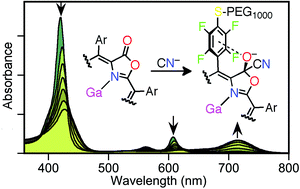Abstract
The colorimetric cyanide sensing ability of free base porpholactone, a pyrrole-modified porphyrin in which a porphyrin β,β′-double bond was replaced by a lactone functionality, and its zinc(II), platinum(II), and gallium(III) complexes in aqueous solution are reported. Water-solubility of the parent meso-pentafluorophenyl-derivatized porphyrinoids was assured by PEGylation of the p-aryl positions using a nucleophilic aromatic substitution reaction with thiol-terminated PEG chains. A central metal-dependent sensing mechanism was revealed: While the CN− adds to the zinc(II) complex as an axial ligand, resulting in a minor response in its UV-vis spectrum, it undergoes a nucleophilic addition to the lactone moiety in the platinum(II) and gallium(III) complexes, leading to a much more prominent optical response. Nonetheless, these chemosensors are less sensitive than many other sensors reported previously, with detection limits at pH 7 for the zinc, gallium, and platinum complexes of 2 mM (50 ppm), 240 μM (6 ppm), and 4 mM (100 ppm), respectively. The gallium(III) complex is weakly fluorescent (ϕ = 0.8%) and cyanide addition leads to fluorescence intensity quenching; the cyanide adduct responds with a fluorescence switch-on response but the signal is weak (ϕ < 10−2%). Lastly, we report on the fabrication of a unique optical cyanide-sensing membrane. The PEGylated gallium-complex was incorporated into a Nafion® membrane (on a PTFE carrier film). It was shown to be stable over extended periods of time and exhibiting a reversible and selective response within minutes to cyanide, with a 5 mM (130 ppm) detection limit. This largely fundamental study on the ability to utilize the once rare but now readily available class of pyrrole-modified porphyrins as chemosensors highlights the multiple principle ways this chromophore platform can be modified and utilized.


 Please wait while we load your content...
Please wait while we load your content...